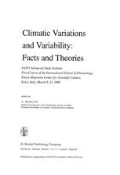Abstract
The increased use of fossil fuels is providing an intense unnatural source of CO2 to the atmosphere (24). That the level of CO2 has been rising rapidly in the atmosphere (Figures 1a, 1b) must mean that other components of the terrestrial biogeochemical system have not fully taken up the new CO2 (25). We can see from Figure 1c that the seasonally adjusted trends of Mauna Loa and Antarctica indicate that the CO2 seems to be well mixed with about 5% increase over a twenty year period. It has been estimated that the CO2 concentration at the beginning of the industrial revolution, about 130 years ago, was 290 ppm, while projections for the future are for 365–395 ppm by the year 2000 and for a doubling by the mid twenty-first century (26).
Access this chapter
Tax calculation will be finalised at checkout
Purchases are for personal use only
Preview
Unable to display preview. Download preview PDF.
References
Keeling, C.D. and Bacastow, R.B.: 1977, in: “Energy and Climate”, Studies in Geophysics, U.S. National Research Council, Geophysics Research Board, pp. 110–160.
Smagorinsky, J.: 1974, in: “Weather and Climate Modification”, W.N. Hess (Ed.), pp. 633–686, Wiley.
Tyndale, J.: 1861, Philadelphia Magazine, J. Science, 22, pp. 169–194, 273–285.
Arrhenius, S.: 1896, Philadelphia Magazine, J. Science, 41, pp. 237–276.
Callendar, G.: 1938, Quart. J. Roy. Met. S. 64, pp. 223–237.
Smagorinsky, J.: 1963, Mon. Wea. Rev. 91, pp. 99–164.
Plass, G.N.: 1956, Tellus 8, pp. 140–154.
Kondratiev, K.Ya. and Niilisk, H.I.: 1960, Geofis. Pura. Appli. 46, pp. 216–230.
Kaplan, L.D.: 1960, Tellus 12, pp. 204–208.
Möller, F.: 1963, J. Geophys. Res. 68, pp. 3877–3886.
Manabe, S. and Wetherald, R.T.: 1967, J. Atmos. Sci. 24, pp. 241–259.
Newell, R.E. and Dopplick, T.G.: 1979, J. Appl. Meteor. 18, pp. 822–825.
Manabe, S. and Strickler, R.F.: 1964, J. Atmos. Sci. 21, pp. 361–385.
Budyko, M.I.: 1969, Tellus 21, pp. 611–619.
Sellers, W.D.: 1969, J. Appl. Meteor. 8, pp. 392–400.
Manabe, S. and Wetherald, R.T.: 1975, J. Atmos. Sci. 32, pp. 3–15.
Manabe, S. and Wetherald, R.T.: 1980, J. Atmos. Sci. 37, pp. 99–118.
Manabe, S. and Stouffer, R.J.: 1979, Nature 282, pp. 491–493.
Manabe, S. and Stouffer, R.J.: 1980, J. Geophys. Res. 85, pp. 5529–5554.
Vonder Haar, T.H. and Oort, A.H.: 1973, J. Phys. Ocean 3, pp. 169–172.
Choudhury, B. and Kukla, G.: 1979, Nature 280, pp. 668–671.
NRC/CRB: 1979, “Carbon Dioxide and Climate-A Scientific Assessment”, Report of and ad hoc study group on carbon dioxide and climate, Woods Hole, Mass., July 23–27, 1979 ( Chairman J.G. Charney ).
In a recent paper (12), Newell and Dopplick used a radiative flux model which took into account turbulent heat transfer. Calculating the turbulent fluxes, they assumed that there were no CO2 induced changes of temperature and water vapor mixing ratio in the overlying atmosphere, whereas, for the radiation change they did allow the atmospheric temperature change to equal that at the surface. As a result an important positive feedback mechanism was suppressed, permitting only a very small surface temperature change (about 1/4 C) in response to a CO2 doubling.
Kellogg, W,: 1981, Awareness of Mankind as a factor in climatic change. This volume.
Bolin, B.: 1981, The carbon cycle.- This volume.
Niehaus, F.: 1981, The impact of energy production on atmospheric CO2-concentrations, This volume.
Ghil, M.: 1981, Energy-balance models: an introduction. This volume.
Rosini, E.: 1981, Climatic impacts on agriculture, water resources and economy. This volume.
Author information
Authors and Affiliations
Editor information
Editors and Affiliations
Rights and permissions
Copyright information
© 1981 D. Reidel Publishing Company, Dordrecht, Holland
About this chapter
Cite this chapter
Smagorinsky, J. (1981). CO2 and Climate - A Continuing Story. In: Berger, A. (eds) Climatic Variations and Variability: Facts and Theories. NATO Advanced Study Institutes Series, vol 72. Springer, Dordrecht. https://doi.org/10.1007/978-94-009-8514-8_37
Download citation
DOI: https://doi.org/10.1007/978-94-009-8514-8_37
Publisher Name: Springer, Dordrecht
Print ISBN: 978-94-009-8516-2
Online ISBN: 978-94-009-8514-8
eBook Packages: Springer Book Archive

